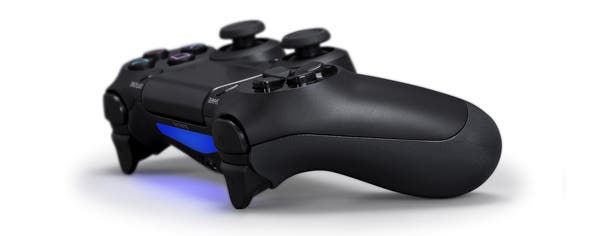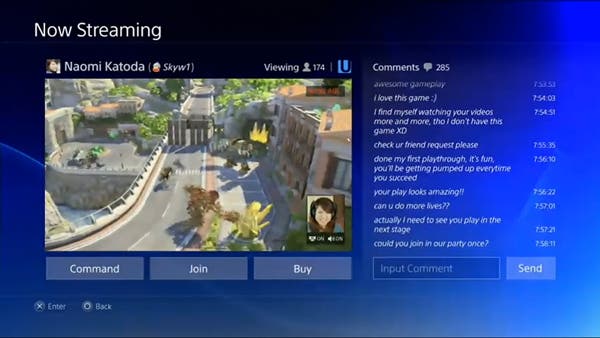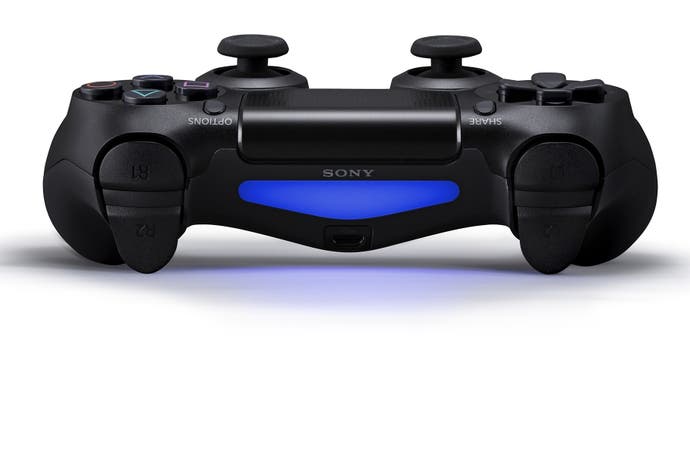Inside PlayStation 4
What Sony told game developers at GDC.
Sony is lifting the lid on PlayStation 4 development, finally revealing detailed technical information on its powerful new platform along with the philosophy that drives it. At GDC yesterday, SCEA senior staff engineer Chris Norden spoke to game developers about the core architecture that powers the new console, going into depth on the controller and camera while giving us some insight into what makes the PS4's x86 64-bit architecture a cut above your typical gaming PC.
A great deal of the presentation centred on what Norden described as "innovative, low-latency input devices" - specifically the DualShock 4 and the new PlayStation 4 Eye. While the new joypad is an evolution of the existing PS3 pad, it features the most fundamental revision of the controller we've yet seen from one generation to the next - going beyond the removal of the Start/Select buttons and the introduction of their Option/Share replacements.
"The analogue sticks have been tightened up, they feel a lot more precise than they did on the DualShock 3," said Norden. "There's a motion sensor... accelerometers, there's a six-axis accelerometer and gyroscope in there. It's better than the one in the PS3, it's better than the one in the PS Vita. You got dual vibration like in DualShock 3 except it's been enhanced. One of the cool features - we've got a touchpad, it's a dual simultaneous touch-point..."
Norden revealed that the touchpad has an exceptional 1920x900 resolution, and that rumble has been significantly improved in the new pad. The vibration motors in the old DS3 had a larger "analogue" unit capable of multiple levels of motion, along with a smaller one that could just turn on and off. In the DualShock 4, both motors have been upgraded to offer varying levels of vibration, defined by the developer. In terms of how the controller feels in the hand, grippier surface materials are utilised to stop thumbs slipping on the sticks, where the deadzone has been refined considerably.

We also got confirmation that a headset will ship in the box with every PlayStation 4.
"Everybody has asked about it, it definitely helps out with voice chat, multiplayer games and everything so we decided to go ahead and do that," Norden remarked. "It's got 32KHz stereo output for two players... frequency will only be reduced slightly when you start cranking up the number of players just because of the bandwidth of the wireless. And there's a 16KHz microphone port as well. The speaker is the same high-quality output as the headset. It streams directly from the PS4 at runtime."
Few games supported it, but the DualShock 3 featured 8-bit precision analogue response not just on the face buttons but on the d-pad and L1 and L2 buttons too. This has been removed on the new controller, with the platform holder reaping the benefits of faster wireless comms with the main console as a consequence.
"They're going back to digital because nobody used them. It increased packet size, it increased latency so now we're able to reduce the amount of data we're sending back from the controller," Norden said. "We've managed to cut that latency way down and as a result the controller feels ridiculously fast and responsive."
The light fantastic
Sony confirmed that the lightbar on the controller is indeed used to track player location in the room - Norden discussed dynamic split-screen with the gamer on the left automatically getting the left screen as opposed to it being allocated by default to player one, with the views shifting if players swapped sides. Similar to PlayStation Move, different players receive different lightbar colours: the first pad gets traditional PlayStation blue, the second gets a red light while the third and fourth controllers illuminate with green and pink respectively - Norden explaining that the colour choice correlates with the colours of the PlayStation symbols on the face buttons. Devs have control over the lightbar to a certain extent, so the LEDs could flash when a player takes damage during a game, for example. The lightbar also flashes while charging, with the pad able replenish its batteries even when the console is in standby.
Applications for the PlayStation 4 Eye camera were also discussed in depth. Firstly, a 1280x800 resolution per camera with 12-bit colour precision and a 60Hz refresh was confirmed, although it was also revealed that developers can trade pixels for frame-rate and that, at its fastest, PlayStation 4 Eye can update at 240Hz. We initially thought that the dual cam would be used for 3D applications and while the tech can triangulate depth in this way, Norden revealed a great many other uses too - the same shot can be acquired simultaneously at different levels of exposure, for example, giving a high-dynamic range effect and boosting low-light performance, while the frame-rate of the camera can be synchronised with the frame-rate of the game. Gesture-tracking and face-tracking libraries are also being provided.
Norden also hinted at Kinect-style gameplay, saying that the PS4 would support controller-free gameplay as well as custom props (reminding the audience of the old PS2 title that was bundled with pom-poms).
"You can get a really good lock on items in the room," he shared. "Cards, AR markers, wrist bands, clothing, LEDs, anything you can think of, you can track - LEDs work really well because it's a nice constant light source but you can do pretty much anything."
The enhanced precision of the PlayStation 4 Eye feeds back into an improved experience using the already superb Move controller:
"[PS4 Eye] actually provides much better tracking than the PS3 camera. Wider field of view, higher resolution," Norden confirmed. "It's just more robust in general because there's more power. Better AR, better head-tracking, better marker tracking, better everything."
Curiously, the camera itself comes with a six-axis accelerometer. There's an 85-degree field of view, but the sensor feeds back to PlayStation 4, letting the console know in what direction the camera is looking. If a game needs a better field of view, this data allows the developer to prompt the player into moving the camera into a better position.

From a technological perspective, details on the hardware make-up of the new console were also forthcoming, with Norden going into a little more depth on the 64-bit x86 architecture from AMD ("low power consumption, low heat, eight-cores, eight hardware threads") but for those keeping up with the PS4 leaks, there was really very little new here, and nothing to contradict existing information.
What was intriguing was new data on how the PlayStation 4's 18-compute-unit AMD graphics core is utilised. Norden talked about "extremely carefully balanced" Compute architecture that allows GPU processing for tasks that usually run on the CPU. Sometimes, employing the massive parallelisation of the graphics hardware better suits specific processing tasks.
"The point of Compute is to be able to take non-graphics code, run it on the GPU and get that data back," he said. "So DSP algorithms... post-processing, anything that's not necessarily graphics-based you can really accelerate with Compute. Compute also has access to the full amount of unified memory."
"The cool thing about Compute on PlayStation 4 is that it runs completely simultaneous with graphics," Norden enthused. "So traditionally with OpenCL or other languages you have to suspend graphics to get good Compute performance. On PS4 you don't, it runs simultaneous with graphics. We've architected the system to take full advantage of Compute at the same time as graphics because we know that everyone wants maximum graphics performance."
Leaked developer documentation suggests that 14 of the PS4's compute units are dedicated to rendering, with four allocated to Compute functions. The reveal of the hardware last month suggested otherwise, with all 18 operating in an apparently "unified" manner. However, running Compute and rendering simultaneously does suggest that each area has its own bespoke resources. It'll be interesting to see what solution Sony eventually takes here.
Low-level access and the "wrapper" graphics API
In terms of rendering, there was some interesting news. Norden pointed out one of the principal weaknesses of DirectX 11 and OpenGL - they need to service a vast array of different hardware. The advantage of PlayStation 4 is that it's a fixed hardware platform, meaning that the specifics of the tech can be addressed directly. (It's worth pointing out at this point that the next-gen Xbox has hardware-specific extensions on top of the standard DX11 API.)
"We can significantly enhance performance by bypassing a lot of the artificial DirectX limitations and bottlenecks that are imposed so DirectX can work across a wide range of hardware," he revealed.
The development environment is designed to be flexible enough to get code up and running quickly, but offering the option for the more adventurous developers to get more out of the platform. To that end, PlayStation 4 has two rendering APIs.
"One of them is the absolute low-level API, you're talking directly to the hardware. It's used to draw the static RAM buffers and feed them directly to the GPU," Norden shared. "It's much, much lower level than you're used to with DirectX or OpenGL but it's not quite at the driver level. It's very similar if you've programmed PS3 or PS Vita, very similar to those graphics libraries."
But on top of that Sony is also providing what it terms a "wrapper API" that more closely resembles the standard PC rendering APIs.
"The key is that it doesn't sacrifice the efficiency of the low-level API. It's actually a wrapper on top of the low-level API that does a lot of the mundane tasks that you don't want to have to do over and over."
The cool thing about the wrapper API is that while its task is to simplify development, Sony actually provides the source code for it so if there's anything that developers don't get on with, they can adapt it themselves to better suit their project.
The PlayStation 4's monstrous memory set-up was also touched upon briefly in the presentation.
"The cool thing about GDDR5 is that it's extremely fast. There's crazy high bandwidth. We have 176GB/s of total bandwidth across the system. This is from GPU, CPU everything... It's a fully unified address space, unified memory. Everything can access everything," Norden said. "If you're coming from PS3 you're used to the split memory architecture, you can't quite use all of it, the speeds are really wacky on some of it. We don't have that. It's eight gigs, it's there, it's easy."
We have heard that the bandwidth levels of certain components vary though. While the GPU has full access to 176GB/s, one source tells us that the CPU is more constrained at around 20GB/s - still pretty good at around two-thirds the level of bandwidth available to Intel's Ivy Bridge. However, depending on how you interpret what Chris Norden said, you could either view PS4 as having unified bandwidth levels across all components or simply that 176GB/s is the maximum level of bandwidth across the entire system. For what it's worth, leaked Durango white papers also seem to suggest that the CPU there has lower levels of bandwidth than its graphics core - and there are many, many similarities between the two next-gen consoles.
From there, the discussion moved onto storage, with confirmation that the PlayStation 4 ships with a dual-layer 50GB Blu-ray drive with speeds up to 3x that of the PS3 unit. There'll be a "very large hard drive" shipped in every console.
Chris Norden summed up the architecture as a "nice, flexible, powerful machine... it's easier to solve real-world problems right now. You don't have to worry about exotic code or weird asymmetric processing or anything. It's nice and simple."
Immediate, frictionless, seamless and fast
Sony also reaffirmed its commitment to resolving one of the major problems that plagues the PS3 platform - system updates and installations that actively get in the way of your gaming. Norden summed up the current situation by saying that he didn't want to go away and make a sandwich or go out for dinner before he starts playing. The new system aims to make play as instant as possible by splitting up the game into chunks - a process the developer has full control over.
"We're going to encourage developers to create their games to have a bare minimum set of data in that first chunk. They download that, they start getting the user into the game so maybe there's intro movies, maybe there's character creation, maybe there's back story happening. So other chunks are downloading in the background and we can minimise the amount of time we're looking at loading screens. Nobody wants to stare at those, it's just not fun."
It all sounds perfect in theory but we're curious about how this is all going to play out in practice in a world where most playable demos - modular game samples similar in concept to what is being suggested here - are usually over 1GB in size. Similarly, Norden also evangelised the sharing of video content, specifically in terms of live-streaming gameplay and allowing other players to comment in real-time. Again, brilliant in theory, but how is this going to work in a world where a majority of broadband customers have dire upload speeds?
In discussing the potential, Norden did let slip with an interesting nugget of info - that live-streaming doesn't just encompass gameplay. A video feed from the PS4 Eye can be super-imposed in a picture-in-picture format, too - a small component in making the whole experience that much more social. Additionally, if you're looking to share some gameplay video, you can set it to upload and put the PS4 into standby. The Liverpool processor within the console features a low-power ARM core that handles tasks like this while machine is otherwise inactive.

The UI was also touched upon - a brand new front-end interface that replaces the PS3's cross-media bar. Again, it's all about making games more social and feeding you a stream of personalised content, as Norden explained:
"We wanted to make sure there was content available whenever the user wants it, we want to make sure you're always connected with your friends as much as possible - that everything is integrated in the system, that everything is easy to get to and easy to use," he said. "And it's personalised, so as you use the system more it learns what you do, what you play, what you like, how your friends act and it integrates all that together and provides you with a really centralised, responsive system."
Selecting a game brings up videos or DLC details, the aim being to drive "engagement" and "purchases", but there's a social element here too with player comments (specifically friends' recommendations) added to the mix. There's a kind of Miiverse vibe to the way the front-end was described, where Sony aims to make the player feel as though he's part of a huge, connected community. This extends to gameplay too - Sony is pushing for connectivity that charts how your friends are progressing in the game, similar to Criterion's Autolog, with the platform holder strongly pushing for this level of connectivity in single-player games too. While it's totally at the discretion of the developer, Norden discussed key decision points in solo adventures being flagged with the choices made by your friends at the same point in the game. Do you follow the choices made by your friends or do you strike out on your own path?
And with that, the presentation wrapped up, with Norden going back to reiterate the main takeaways of his talk - that the PS4 is "cutting-edge, extremely powerful hardware" backed by "very powerful, easy-to-use tools". Again he emphasised the importance of a "highly connected, very social experience" with "sharing so effortless, everyone does it... growing the community". The importance of taking PlayStation 4 with you via Vita, iOS and Android was also stressed.
The impression we got was of a platform holder hugely confident in the prowess of its hardware and of the concepts with which it has backed it. What excites us the most is that we have some seriously capable technology here, with Sony providing the means for developers to get far more from the architecture than is possible on PC. Now it's a case of seeing how that translates into the actual games - something we hope to see at E3...


